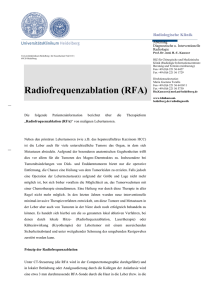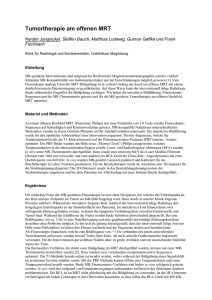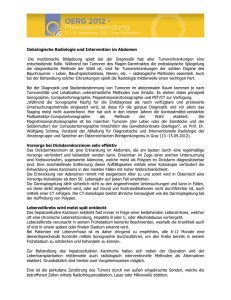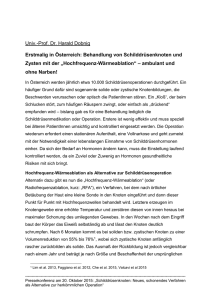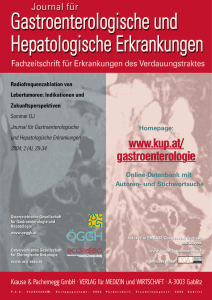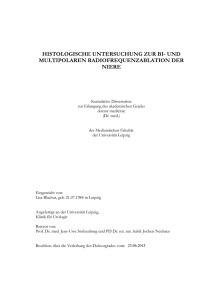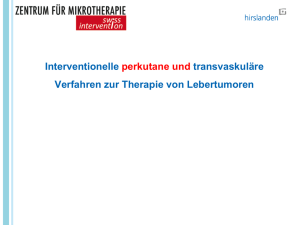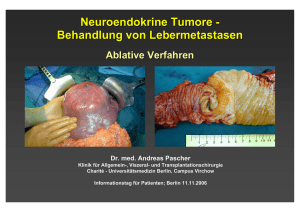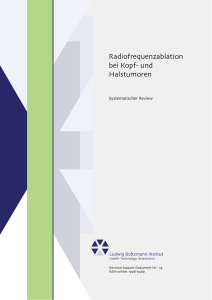Extrahepatische lokale Tumortherapie – was macht Sinn?
Werbung
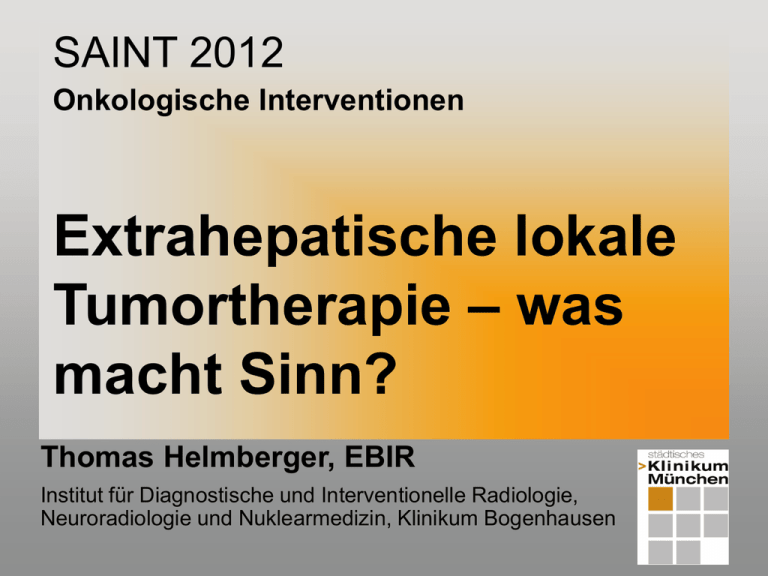
SAINT 2012 Onkologische Interventionen Extrahepatische lokale Tumortherapie – was macht Sinn? Thomas Helmberger, EBIR Institut für Diagnostische und Interventionelle Radiologie, Neuroradiologie und Nuklearmedizin, Klinikum Bogenhausen Lokale Tumortherapie ●Leber ✔ ●Extrahepatische Tumoren – Indikationen • Lunge • Niere • Knochen – Ergebnisse Ablation Lungentumoren Bronchial CA Rationale für minimal-invasive TU-Therapie ● Non-small cell lung cancer (NSCLC) 80% ● Chirurgische Resektion Methode der Wahl beim frühen NSCLC – Aber: Limitationen aufgrund Komorbiditäten (z.B. COPD etc.) – Hohe Rezidivwahrscheinlichkeit bei NSCLC ● Limitierter Outcome von CTx und Radiotherapie Pulmonale Metastasen Rationale für minimal-invasive TU-Therapie ● Lunge 2. häufigster Manifestationsort für Metastasen ● Bekannter Überlebensvorteil nach Rx ● OP limitiert durch – Anzahl und Lokalisation der Metastasen – Verlust an funktionellem Lungengewebe – Relativ hohes Rezidivrisiko Indikationen IGT ● Sekundäre Malignome + NSCLC ● OP nicht möglich (technisch und/oder allg. med. Gründe; Einzellunge) ● LebenserwartungIntention: > 3 Monate ● Erkennbarer TU ohne prognosebestimmende Potentielle Heilung Fernmetastasen Überlebensverlängerung ● Bis zu 6 + ? Läsionen (beide Lungen) ● Dmax 3 (5) cm (Dmin 0,5 cm?) ● Palliation (Schmerz, Dekompression, Hämoptyse) CT-Fluoroskopie RFA NSCLC Rezidiv 3 Monate post Lage < 2 cm von zentralen Strukturen! RFA Mamma CA Mets Cavitation mgl. RFA 6 W post RFA RFA Mamma CA Mets RFA 6 W. post RFA Follow-up – “Läsionsreifung” ● Morphologische Evaluation mit CT Longest Diameter (cm) – 35 Monate – 3 – 3 – 3 – 6 – 6 … Max diam Vergleich mit Baseline 4 3 2 1 Baseline 0 Tumor nach RF 24-48 h 17 ± 9 32 ± 11 39 ± 13 0 stabil/ kleiner = Erfolg größer = Rezidiv/Residual TU 2 Mon From RAPTURE trial 4 Mon 25 ± 9 Day 1 3 6 23 ± 9 2 mths 9 Mon 12 MOn 20 ± 7 20 ± 8 8 mths 9 15 mths 12 Months Primary RFA End of RFA Metastatic Aus RAPTURE Trial RFA Komplikationen Minor complications* ● Pneumothorax – Drainage ● Pleuraerguß ● Hämorrhagische Infiltration ● Cavitation ● Post interv. Schmerz 50 % 24 - 50 % 20 % 7.5 % 24 % 12 % Keine major complications* Steinke et al., 2003, JCAT; Hiraki et al., 2006, Radiology; Literaturreview: Rose SC et al. 2006, JVIR 17:927-951; Okuma et a. 2007 CVIR; D. Dupuy 2011, Radiology; * SIR guidelines Fatale kutane Fistel mit Abszeß Cave Zugangsweg! Rose SC et al. 2006, JVIR 17:927-951 Überleben nach RFALunge ● 60 Pat/100 TU/168 RFA, Ø 17 ± 9 mm (4-42 mm) – Inkompl. RFA/18 Mon < 2cm > 2cm 5% 13 % – OP-Rezidive 2-12% (Kodama K et al.1997, J Thorac Cardiovasc Surg 1997; Yano T et al. J Am Coll Surg 1995) > 90 % = 70 % 2. 5- 3. 5 cm ≤ 50 % TU frei gesamt 4/5 cm De Baère T et al. 2006, Radiology, 240:587-596 Rapture - Gesamtüberleben A ll C ause S urvi val 1.00 2-yr 62% CRCpulm 0.75 Meta, 27 Monate 0.50 2-yr 48% CRC (n = 53) 0.25 Other (n = 20) NSCLC (n = 33) NSCLC, 21 Monate 0.00 0 5 10 15 20 survti m e 25 30 35 RFA Komplikationen & ÜL LC 137 Pat./215 Sessions 5-J ÜL 40,2% med. ÜL 44,4 M Metas 283 Pat./785 Sessions 5-J ÜL 35,9% med. ÜL 36,0 M Kashima, M., et al., Complications after 1000 lung radiofrequency ablation sessions in 420 patients: a single center's experiences. AJR Am J Roentgenol, 2011. 197(4): W576-80 LC: RFA vs Rx +/- CTx Lee, H., et al., Comparison of survival rate in primary non-small-cell lung cancer among elderly patients treated with radiofrequency ablation, surgery, or chemotherapy. Cardiovasc Intervent Radiol, 2012. 35(2): p. 343-50 LC: Rx vs RFA +/- CTx Lee, H., et al., Comparison of survival rate in primary non-small-cell lung cancer among elderly patients treated with radiofrequency ablation, surgery, or chemotherapy. Cardiovasc Intervent Radiol, 2012. 35(2): p. 343-50 RFA vs RTx, St I NSCLC Haasbeek, C. J., S. Senan, et al. (2008). "Critical review of nonsurgical treatment options for stage I non-small cell lung cancer." Oncologist 13(3): 309-19. NSCLC: sRTx vs RFA ● Metaanalyse: 16/219 (2004 -2011) sRTx ● 1-J ÜL 81-85.7% ● 3-J ÜL 42.7-56% ● 5-J ÜL 47% ● Lokaler Progress 3.5-14.5%* ● Komplikationen – – – – Pneumothorax Fatigue Pneumonitis TH-Wand Schmerz 31-32.6% 2.1-12.5% 3.1-12% RFA 68.2-95% 36-87.5% 20.1-27% 23.7-43% 19.1-63% *Tu-Kontrollrate für 3 cm >> 5 cm Bilal, H., et al., Is radiofrequency ablation more effective than stereotactic ablative radiotherapy in patients with early stage medically inoperable non-small cell lung cancer? Interact Cardiovasc Thorac Surg, 2012. 15(2): 258-65 ∑ - Lungenablation ● Alternative Behandlung für nicht-chirurgische TU – Komplementär zu CTx/RTx ● Einfach, sicher, wiederholbar ● Suffiziente TU-Kontrolle (< 2,5-3 cm) ● Niedrige Komplikationsrate ● Offene Fragen – – – – Indikationen Änderung der Prognose Multimodale Therapiekombinationen Kompetition mit anderen minimal-invasiven Verfahren (z.B. SRTx, VATS) Ablation Nierentumoren Indikation für lokale Ablation ● Komorbiditäten ● Einzelniere ● Multiple RCC Interdisziplinäre Entscheidung ● Von Hippel-Lindau ●Urologie S. ● Familiäres RCC ●Interventionelle Radiologie ● Nierenfunktionseinschränkungen ●Onkologie ● Lebenserwartung > 1 J ● Ablehnung OP Indikation für lokale Ablation ● TU Diameter < 5 cm ● Exophytische oder parenchymale Lokalisation ● Zentrale Lokalisation bei Hämaturie* ● Extrarenale Metastasierung, ohne Beeinträchtigung der Lebenserwartung, z.B. durch Immunotherapie kontrollierte Mikronoduläre Lungenmetas *Wood BJ et al., J Urol 2001, 166; Gervais DA et al., Radiology, 2000, 217 Kontraindikationen ● Multiple große Tumoren ● Signifikante extrarenale Metas ● Lebenserwartung < 3 M Relativ ● Thrombozyten< 50.000 ● Akute Infektion ● Akuter Harnwehsinfekt RFA, 2cm RCC 78j. ♂, Diabetes mell., kompensierte NI 6 M post RFA, NI weiterhin kompensiert 3 cm RCC Superselektive PartikelLipiodol-Embolisation vor RFA 3 cm RCC 9 m f-up 3 d post RFA Technischer Erfolg Unabhängige Prognosefaktoren für komplette Ablation Größe periphere Lokalisation ● Einzelablation .0001 .0049 ● Multiple Ablationen .059 .015 Gervais DA et al., AJR 2005, 185 RFA nahe NBKS ● Kein erhöhtes Risiko für inkomplette Ablation durch Nähe zu Kelchsystem oder NB ● Aber: erhöhtes Blutungsrisiko Prä RFA post RFA ● Ureterstrikturen ● Leckage Gervais D et al., AJR 2005; 185:72-80 RFA - Komplikationen ● Hemorrhagie – Perirenal – In NBKS (cave: Koagelobstruktion!) ● NBKS Komplikationen – Striktur, Urinom, Leackage ● Paraesthesie der anterioren Bauchwand – Kurzfristig und selbstlimitierend ● Sonstige ● Insgesamt < 2 % Rhim H et al. Radiographics 2004; Venkatesan, A.M., B.J. Wood, and D.A. Gervais, Percutaneous ablation in the kidney. Radiology, 2011. 261(2): p. 375-91 Perkutan – laparoskopisch? ● PubMed 1996 - 2006 ● 46 Studien (>1 Fall, RFA/Cryo, FU, Komplikationen) ● Prim. Erfolg ● Kum. Erfolg ● Komplikationen 28 perk. 87% 92% 3% 18 lap. 94% 95% 7% (p<0.05) (n.s.) (p>0.05) Hui GC, Tuncali K, Tatlis S et al.:Comparison of percutaneous approaches to renal tumor ablation: metaanalysis of effectiveness and complication rate J Vasc Interv Radiol. 2008 Sept;19(9):1311-20 Outcome RFA ● 151 Pat/163 TU, MW F-up 18 M(1.5-70) ● Tumor 1 - 5,4 cm (MW 2,3 cm) ● RCC 70% ● Komplette primäre Ablation 97% – Vitaler Tumor – Lokalrezidiv – Metastases ● Gesamt Rez.-freies ÜL 5/163 3.3% 1.3% 97%/1a 92%/3a Gupta A, Raman JD, Leveillee RJ et al. General anesthesia and contrast-enhanced computed tomography to optimize renal percutaneous radiofrequency ablation: multi-institutional intermediate-term results. J. Endourol.2009 Jul:23(7):1099-105 Nierenfunktion nach RFA ● 63 Pat. (4 ASA 1, 59 ASA II)* ● Solitäre TU 1,0 -4,0 cm (Med 2.1) ● Zuvor Biopsie in 89 % (75% RCC) ● MW F-up 34 M (1 - 80) ● Lokalrezidiv 1/63 (55 M post RFA) ● Kompensierte NI ● eGFR 20% pre RFA 76,3 mL/min/m2 post RFA 74,3 mL/min/m2 Stern JM et al. Radiofrequency ablation of small renal cortical tunours in healthy adults Renal function preservation and intermediate oncological outcome BJU. 2009; 104:786-789 Cryo - RFA ● Medline: 47 Studien (1375 TU) ● Cryoablation ● RFA ● Kein Unterschied bzgl. – Patientenalter – Läsionsgröße – Follow-up (86% lap.) (94% perk.) (P = .17) (P = .12) (P = .53) ● Erneute RFA >> Cryo (8.5% vs 1.3%; P<.0001) ● Rezidiv RFA >> Cryo (12.9% vs 5.2%; P<.0001) Kunkle DA,Uzzo RG: Cryoablation or radiofrequency ablation of the small renal mass: a meta-analysis. Cancer. 2008 15;113 RFA Langzeiterfahrung Tracy, C.R., et al., Durable oncologic outcomes after radiofrequency ablation: experience from treating 243 small renal masses over 7.5 years. Cancer, 2010. 116(13): 3135-42 RFA Langzeiterfahrung Tracy, C.R., et al., Durable oncologic outcomes after radiofrequency ablation: experience from treating 243 small renal masses over 7.5 years. Cancer, 2010. 116(13): 3135-42 Review ● Medline 1/2003 – 5/2011: 717 : 17 Studien ● Patho gesicherte RCCs 82,3 % ● Lokale Erfolgsrate 67 – 100 % – Wiederholte RFA (8,8 %) ● Komplikationen – Minor (Grad I, II) – Major (Grad III, IV) 89,7 – 100 % 13,2 % 10 % 3,2 % ● PFS 79,9 – 93,8 % (53 – 61,2 M F-up) ● Cancer-specific ÜL 98 – 100 % ● Ges ÜL 58,3 – 85 % Joniau, S., M. Tsivian, and P. Gontero, Radiofrequency ablation for the treatment of small renal masses: safety and oncologic efficacy. Minerva Urol Nefrol, 2011. 63(3): 227-36 Ergebniss PubMed - 2012 Autor TU/Pat Mean FU Mean TU (cm) Biopsie % RCC % Primär Erfolg 3&5y Rez. frei 3&5J TU abh ÜL 3&5J ges ÜL McDoug al 2005 23/19 55 3.1 100% 87% 69% n.a. 100%& 100% 64%& 55% Levinso n 2008 34/31 62 2.1 100% 51% 97% 90% 100% 58% @ 31 M @ 57 M @ 57 M Tracey 2010 243/208 27 2.4 93% 79% 93% 93% & 93% 95% & 99% n.a.& 85% Takaki 2010 51/51 34 2.4 n.a. n.a. 82% n.a. & 98% 100% & 100% n.a.& 75% Ferakis 2010 39/31 61 3.1 0% n.a. 98% 92% & 89% n.a. n.a. Ji 2011 106/106 32 n.a. 100% 85% 98% 98% 100% 100% @ 32 M @ 32 M @ 32 M AUA Guideline EUA Guideline … Compared to RFA, cryoablation is more likely to be performed laparoscopicaIly. The laparoscopic approach is more effective but has a higher complication rate. Repeat ablation is necessary more frequently following RFA. Local tumour progression is significantly higher with RFA. Cancerspecific survival rates for cryotherapy and RFA are poorer than survival rates for surgical procedures ∑ - Nierenablation ● Umfangreiche Datenlage (urologisch + radiologisch) ● Perkutane RFA – Sicher, effizient – Tumorkontrollrate ≈ PN >> 90 %/5a ● HiFU, IRE etc. Datenlage schwach, bisher schlechtere Ergebnisse ● TA effizienten minimalinvasive Alternative Ablation Knochentumoren IR Therapie bei Knochentumoren ● Kausale, definitive Therapie von Osteoid osteomen ● Symptomatisch, supportive (palliativ) Therapie bei malignen Knochentumoren RFA bei Osteoid Osteom ● Komplette Destruktion des Nidus ● Indikation – Typische Anamnese, Aspirin Test nicht immer positiv – Nidus muß erkennbar sein ● Ablation – Aktive Elektrodenspitze im Nidus – Leistung 3-10 W/4-10 Min. Pinto et al.; AJR (2002); 179:1633-1642 Rosenthal et al.; J Knochen Joint Surg Am (1998); 80:815-82 Rosenthal et al. (1992) Radiology 183:29-33 RFA bei Osteoid Osteom Single Elektrode Kühlung mit Glucose 11-j. Mädchen Aspirin-positiver Schmerz seit 6 Monaten RFA bei Osteoid Osteom Reduzierter, aber noch persistierender Schmerz - inkomplette Ablation 2. Versuch mit Schirmartiger Elektrode 11-j. Mädchen Aspirin-positiver Schmerz seit 6 Monaten, nach 1. RFA RFA bei Osteoid Osteom Zugang über Gegenseite Knochenbohrer 10-j. Junge – OO rechter Femur single Elektrode RFA bei Osteoid Osteom Knochen bohrer single Elektrode 49-j. Frau, OO rechter Oberschenkelhals Unmittelbare Schmerzfreiheit RFA bei Osteoid Osteom Author Pat/Prozed. Prim. Erfolg Sek. Erfolg Ges. Erfolg Komplikationen F-up/Mon. Burns (n=1) Burns (n=1) Broken needle (n=1) Burns (n=1) transient Paresthesia (n=1) Anesthesia (n=1) sympathic Dystrophy (n=1) Cellulitis (n=1) Burns (n=1) Osteomyelitis (n=1) Burns (n=1) Tendinitis (n=1) Burns (n=1) Phlebitis (n=1) Gesamt *126/263 pat. evaluated over 2 years, case histories and redundant studies were not considered Mahnken et. al, Dt. Ärzteblatt 103, 2006 RFA bei Osteoid Osteom ● Erfolg – Primär – Sekundär (2. RFA 2 w nach 1.) 60 – 85 % 90 – 100 % ● Komplikationen (minor & major < 2.5 %) – – – – Blutung Mechanischer und thermischer Schaden Hautverbrennung Inkomplette Ablation mit Rezidivbeschwerden RFA bei Knochentumoren Rationale für Schmerzlinderung ● Thermische Denaturierung von Nozizeptoren (Periost + Umgebung) ● Reduktion der Tumormasse mit sekundärer Reduktion von – Intrinsischem Gewebedruck innerhalb der Umgebung – Tumornekrosefaktoren und Interleukinen ● Hemmung von Osteoklast Cleeland et al., (1994) N Engl J Med, 330:559-596 Mannion et al., (2000) Clin J Pain, 16:144-156 IR Therapie bei Knochentumoren ● Indikationen – OP nicht möglich – Radiatio nicht möglich oder noch nicht geplant/gewünscht – Schmerztherapie – Vorbereitung zur Kombination mit Osteooplastie • Vorbereitung der TU Matrix für Injektion – Adjuvant zu anderen Therapien (Radiatio, CTx) ● (Relative) Kontraindikationen – Infiltration von Neuro-Strukturen RFA bei Knochentumoren ● Vor/anstatt Radiatio ● Vor Osteoplastie ● Vor/anstatt OP ● Ausschließlich? 3 Monate später Anamnese: Radiatio des Beckens mit 56 Gy RFA bei Knochen Metastasen 58-j. Mann, metastasierendes RCC, L5, Schmerz Knochen noch stabil RFA bei Knochen Metastasen Kühlung mit Glucose 58-j. Mann, metastasierendes RCC, L5, Schmerz Knochen noch stabil Adjuvante Osteoplastie Zusätzliche Stabilisierung mit PMMA Zement Schmerzlinderung nach RFA Göetz et al. J of Clinical Oncology, 22, 2004 RFA bei Knochen Metastasen ● Daten bisher noch sehr begrenzt ● Keine RCT‘s Author Technik Patienten Erfolg Callstrom et al. (Radiology, 2002) RFA 12 12/12 Charboneau (SIR, 2004) Goetz et al. (J Clin Oncol, 2004) RFA 43 41/43 Eigene Daten (RSNA, 2003) (ESSR, 2004) RFA 18 16/18 Schmerzlinderung nach RFA Göetz et al. J of Clinical Oncology, 22, 2004 Knochen Metastasen Ossäres Ereignis KMInfiltration HyperKalzämie Panzytopenie + Folgen metabolische Störung systemische Therapie Chemotherapie, Bisphosphonate Periostreaktion Fraktur Risiko Weichteil Kompression Schmerz und Funktionsverlust lokale Therapie OP, Vertebroplastie, Chemo- und thermoablative Prozeduren, Radiotherapie ∑ -Knochenablation ● Methode der Wahl beim Osteidosteom ● Potente therapeutische Option bei Malignomen – – – – Nicht-radiosensitive Tumoren Strahlendosis schon erschöpft Chemo-insensitive Tumoren Reduktion von Nebenwirkungen von Opiaten ● Effektivität bei Schmerzlinderung ● Sehr niedrige Komplikationsrate > 90% < 5% Extrahepatische Ablation ● Ablative Verfahren – Sicher – Einfach – Effektiv – Indikation muß in MDBs abgestimmt sein ● „Wenn resektabel, dann auch abladabel“ ● Keine Angst, wenn‘s nicht die Leber ist Vielen Dank !



